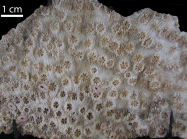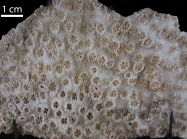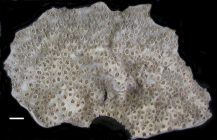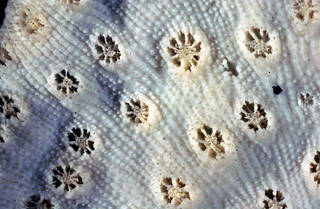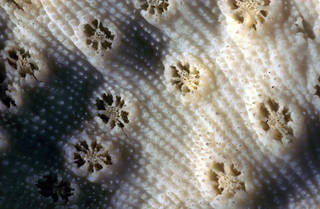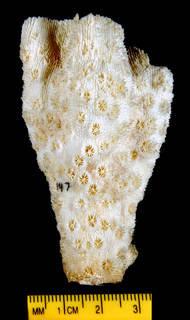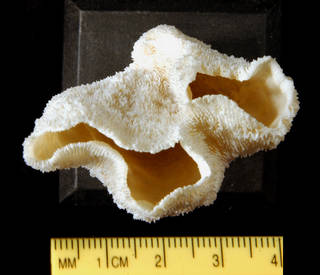
| Intro | | About | | Wiki | | Search traits | | Data explorer | | Literature | | Definitions | | Sources | | Webservices | | Statistics | | Feedback | | Editors | | Log in |
WoRMS taxon detailsEchinopora lamellosa (Esper, 1791)
207421 (urn:lsid:marinespecies.org:taxname:207421)
accepted
Species
Echinastrea rosularia (Lamarck, 1816) · unaccepted > junior subjective synonym
Echinopora concinna Verrill, 1901 · unaccepted > junior subjective synonym
Echinopora elegans Verrill, 1901 · unaccepted > junior subjective synonym
Echinopora flexuosa Verrill, 1864 · unaccepted > junior subjective synonym
Echinopora litae Nemenzo & Montecillo, 1981 · unaccepted > junior subjective synonym
Echinopora reflexa Dana, 1846 · unaccepted > junior subjective synonym
Echinopora rosularia Lamarck, 1816 · unaccepted > junior subjective synonym
Echinopora striatula Studer, 1878 · unaccepted > junior subjective synonym
Echinopora undulata Dana, 1846 · unaccepted > junior subjective synonym
Madrepora lamellosa Esper, 1791 · unaccepted > superseded combination (basionym)
Matrepora lamellosa (Esper, 1791) · unaccepted > superseded combination
marine,
recent + fossil
(of Madrepora lamellosa Esper, 1791) Esper, E.J.C. (1788-1830). Die Pflanzenthiere in Abbildungen nach der Natur mit Farben erleuchtet nebst Beschreibungen. Raspischen Buchhandlung, Nuremberg. 3 vols text, 2 vols pls. , available online at https://doi.org/10.11588/diglit.2885 [details]
Description Colonies are usually thin leaves. Calices are 3 to 6 mm in diameter, and in general are spaced about a corallite diameter...
Description Colonies are usually thin leaves. Calices are 3 to 6 mm in diameter, and in general are spaced about a corallite diameter apart. Costae run between septa and are beaded. The primary septa are markedly exsert, and bear paliform lobes. This is a common species on steep Red Sea reef slopes, generally below 15 m deep, and in lagoons of Indian Ocean atolls at depths to 25 m. (Sheppard, 1998 <308>) Colonies consist of thin laminae arranged in whorls or tiers or, rarely, forming tubes. Corallites are relatively thin-walled and have calices 2.5-4.0 mm in diameter. Columellae are small and compact, and paliform lobes are well developed. Colour: Amber, pale to dark brown or greenish, often with darker-brown or green calices. Abundance: common and may be dominant in shallow-water habitats with flat substrates. (Veron, 1986 <57>) Resembles E. gemmacea, but corallites smaller (usually 4-6 mm across). Forms plates which may be encrusting or contorted and foliose; these are thinner (<1 cm thick), more fragile, unbranched and often with free edges. Colonies dominate reef slopes. Habitat: diverse. (Richmond, 1997) [details]
Hoeksema, B. W.; Cairns, S. (2025). World List of Scleractinia. Echinopora lamellosa (Esper, 1791). Accessed through: World Register of Marine Species at: https://www.marinespecies.org/aphia.php?p=taxdetails&id=207421 on 2025-07-17
Date action by
Nomenclatureoriginal description
(of Echinopora concinna Verrill, 1901) Verrill A. E. (1901). Variations and nomenclature of Bermudian, West Indian and Brazilian reef corals, with notes on various Indo-Pacific corals. <em>Transactions of the Connecticut Academy of Arts and Sciences.</em> 11: 63-168., available online at https://www.biodiversitylibrary.org/page/13464046 [details] original description (of Echinopora striatula Studer, 1878) Studer T. (1878). Übersicht der Steinkorallen aus der Familie der Madreporaria aporosa, Eupsammina und Turbinaria, welche auf der Reise S.M.S. Gazelle um die Erde gesammelt wurden. <em>Monatsberichte der Königlichen Preussischen Akademie der Wissenschaften zu Berlin.</em> 1877: 625-655, pls. 1-4. [details] original description (of Echinopora rosularia Lamarck, 1816) Lamarck, [J.-B. M.] de. (1816). <i>Histoire naturelle des animaux sans vertèbres</i>. Tome second, 566 pp. Paris, Verdière. , available online at http://www.biodiversitylibrary.org/item/47698 [details] original description (of Echinopora litae Nemenzo & Montecillo, 1981) Nemenzo F, Montecillo E (1981) Four new Scleractinia species from Arangas Islet (Surigao del Sur Province, Philippines). The Philippine Scientist 22: 157-167. [details] original description (of Madrepora lamellosa Esper, 1791) Esper, E.J.C. (1788-1830). Die Pflanzenthiere in Abbildungen nach der Natur mit Farben erleuchtet nebst Beschreibungen. Raspischen Buchhandlung, Nuremberg. 3 vols text, 2 vols pls. , available online at https://doi.org/10.11588/diglit.2885 [details] original description (of Echinopora undulata Dana, 1846) Dana, J.D. (1846-1849). Zoophytes. United States Exploring Expedition during the years 1838-1842. <em>Lea and Blanchard, Philadelphia.</em> 7: 1-740, 61 pls. (1846: 1-120, 709-720; 1848: 121-708, 721-740; 1849: atlas pls. 1-61)., available online at https://www.biodiversitylibrary.org/page/18989497, http://www.sil.si.edu/digitalcollections/usexex/navigation/ScientificText/USExEx19_08select.cfm [details] original description (of Echinopora reflexa Dana, 1846) Dana, J.D. (1846-1849). Zoophytes. United States Exploring Expedition during the years 1838-1842. <em>Lea and Blanchard, Philadelphia.</em> 7: 1-740, 61 pls. (1846: 1-120, 709-720; 1848: 121-708, 721-740; 1849: atlas pls. 1-61)., available online at https://www.biodiversitylibrary.org/page/18989497, http://www.sil.si.edu/digitalcollections/usexex/navigation/ScientificText/USExEx19_08select.cfm [details] original description (of Echinopora flexuosa Verrill, 1864) Verrill, A. E. (1864). List of the polyps and corals sent by the Museum of Comparative Zoology to other institutions in exchange, with annotations. <em>Bulletin of the Museum of Comparative Zoology.</em> 1: 29-60., available online at https://www.biodiversitylibrary.org/page/6587563 [details] original description (of Echinopora elegans Verrill, 1901) Verrill A. E. (1901). Variations and nomenclature of Bermudian, West Indian and Brazilian reef corals, with notes on various Indo-Pacific corals. <em>Transactions of the Connecticut Academy of Arts and Sciences.</em> 11: 63-168., available online at https://www.biodiversitylibrary.org/page/13464046 [details] basis of record Veron JEN. (1986). Corals of Australia and the Indo-Pacific. <em>Angus & Robertson Publishers.</em> [details] Othercontext source (Hexacorallia)
Fautin, Daphne G. (2013). Hexacorallians of the World. (look up in IMIS) [details]
additional source Veron JEN, Pichon M, Wijsman-Best M. (1977). Scleractinia of Eastern Australia – Part II. Families Faviidae, Trachyphylliidae. <em>Australian Institute of Marine Science Monograph series.</em> 3: 1-233. [details] additional source Vaughan TW. (1918). Some shallow-water corals from Murray Island (Australia), Cocos-Keeling Island, and Fanning Island. <em>Papers from the Department of Marine Biology of the Carnegie Institution of Washington.</em> 9 (213): 49-234, pls. 20-93. [details] additional source Cairns, S.D., B.W. Hoeksema & J. van der Land. (1999). Appendix: List of extant stony corals. <em>Atoll Research Bulletin.</em> 459: 13-46. page(s): 28 [details] additional source Randall RH. (2003). An annotated checklist of hydrozoan and scleractinian corals collected from Guam and other Mariana Islands. <em>Micronesica.</em> 35-36: 121-137. page(s): 133 [details] additional source Cairns, S.D., B.W. Hoeksema & J. van der Land. (2007). as a contribution to UNESCO-IOC Register of Marine Organisms. (look up in IMIS) [details] additional source Liu, J.Y. [Ruiyu] (ed.). (2008). Checklist of marine biota of China seas. <em>China Science Press.</em> 1267 pp. (look up in IMIS) [details] Available for editors additional source Rehberg, H. (1892). Neue und wenig bekannte Korallen. <em>Abhandlungen aus dem Gebiete der Naturwissenschaften Hamburg.</em> 12: 1-50. page(s): 23 [details] additional source Veron JEN. (2000). Corals of the World. Vol. 1–3. <em>Australian Institute of Marine Science and CRR, Queensland, Australia.</em> [details] additional source Veron JEN. (2002). New species described in Corals of the World. <em>Australian Institute of Marine Science Monograph Series.</em> 11: 1-209. page(s): 174 [details] additional source Scheer G, Pillai CSG. (1974). Report on Scleractinia from the Nicobar Islands. <em>Zoologica, Stuttgart.</em> 42(122): 1-75. page(s): 9, 54-55, 74 [details] additional source Thiel, M.E. (1932). Madreporaria. Zugleich ein Versuch einer vergleichenden Oekologie der gefundenen Formen. Resultats scientifiques du Voyage aux Indes Orientales Neerlandaises. <em>Memoires du Musée Royal d'Histoire Naturelle de Belgique.</em> 2(12): 1-177, pls. 1-21. [details] Available for editors additional source Matthai G. (1914). A revision of the recent colonial Astraeidae possessing distinct corallites. <em>Transactions of the Linnean Society of London, 2nd Series Zoology.</em> 17(1): 1-140, pls. 1-38. [details] additional source Umbgrove JHF. (1940). Madreporaria from the Togian Reefs (Gulf of Tomini, North-Celebes. <em>Zoologische Mededelingen, Leiden.</em> 22: 265-310. page(s): 271, 289 [details] additional source Umbgrove JHF. (1939). Madreporaria from the Bay of Batavia. <em>Zoologische Mededelingen, Leiden.</em> 22: 1-64. page(s): 9, 18, 20, 38, 39 [details] additional source Yabe H, Sugiyama T, Eguchi M. (1936). Recent reef-building corals from Japan and the South Sea Islands under the Japanese mandate. I. <em>The Science reports of the Tôhoku Imperial University, Sendai, 2nd Series (Geologie).</em> Special Volume 1: 1-66, pls. 1-59. page(s): 4, 48-49, Pl. LVIII [details] additional source Yabe H, Sugiyama T. (1935). Revised list of the reef-corals from the Japanese seas and of the fossil reef corals of the raised reefs and the Ryukyu limestone of Japan. <em>Journal of the Geological Society of Japan.</em> 42: 379-403. page(s): 386, 395 [details] additional source Pillai CSG, Scheer G (1976) Report on the stony corals from the Maldive Archipelago. Results of the Xarifa Expedition 1957/58. Zoologica, Stuttgart 43 (126): 1-83, pls. 1-32. [details] additional source Crossland C (1952) Madreporaria, Hydrocorallinae, Heliopora and Tubipora. Scientific Report Great Barrier Reef Expedition 1928-29 VI(3): 85-257. page(s): 90, 99 [details] additional source Chevalier JP. (1975). Les Scléractiniaires de la Mélanésie Française (Nouvelle-Caledonie, Iles Chesterfield, Iles Loyauté, Nouvelles Hébrides). II. Expedition Française sur les Récifs Coralliens Nouv.-Calédonie. 7: 1-407, pls. 1-42. Paris. [details] additional source Wijsman-Best M (1977) Indo-Pacific coral species belonging to the subfamily Montastreinae Vaughan and Wells, 1943 (Scleractinia-Coelenterata) Part I. The genera Montastrea and Plesiastrea. Zoologische Mededelingen, Leiden 52: 81-97. page(s): 93 [details] additional source Wijsman-Best M (1980) Indo-Pacific coral species belonging to the subfamily Montastreinae Vaughan and Wells, 1943 (Scleractinia-Coelenterata) part II: The genera Cyphastrea, Leptastrea, Echinopora and Diploastrea. Zoologische Mededelingen, Leiden 55: 235-263. [details] additional source Nemenzo F (1959) Systematic studies on Philippine shallow water scleractinians: II. Suborder Faviida. Natural and Applied Science Bulletin, University of the Philippines 16: 73-135, pls. 1-24. page(s): 76, 118 [details] additional source Pichon, M.; Benzoni, F. (2007). Taxonomic re-appraisal of zooxanthellate Scleractinian Corals in the Maldive Archipelago. <em>Zootaxa.</em> 1441: 21–33. page(s): 32 [details] additional source Huang D, Benzoni F, Fukami H, Knowlton N, Smith ND, Budd AF (2014) Taxonomic classification of the reef coral families Merulinidae, Montastraeidae, and Diploastraeidae (Cnidaria: Anthozoa: Scleractinia). Zoological Journal of the Linnean Society 171: 277–355., available online at https://doi.org/10.1111/zoj.12140 [details] additional source Matthai G (1924) Report on the madreporarian corals in the collection of the Indian Museum, Calcutta. Memoirs of the Indian Museum 8: 1-59. [details] additional source Kitahara, M.V., J. Stolarski, S.D. Cairns, F. Benzoni, J.L. Stake & D.J. Miller. (2012). The first modern solitary Agariciidae (Anthozoa, Scleractinia) revealed by molecular and microstructural analysis. <em>Invertebrate Systematics.</em> 26 (3): 303-315., available online at https://doi.org/10.1071/is11053 page(s): 305, 307 [details] Available for editors additional source Faustino LA. (1927). Recent Madreporaria of the Philippine Islands. <em>Bureau of Science Manila Monograph.</em> 22: 1-310, pls. 1-100. page(s): 11, 37, 40, 122-123, 124 [details] additional source Veron JEN, Marsh LM. (1988). Hermatypic corals of Western Australia : records and annotated species list. <em>Records Western Australian Museum Supplement.</em> 29: 1-136., available online at https://doi.org/10.5962/bhl.title.60555 page(s): 28, 115 [details] additional source Pillai CSG. (1972). Stony corals of the seas around India. <em>Proceedings of the First International Symposium on Corals and Coral Reefs, 1969. Marine Biological Association of India Symposium.</em> 5: 191-216. page(s): 207 [details] additional source Boshoff, P.H. (1981). An annotated checklist of Southern Africa Scleractinia. <em>Oceanographic Research Institute Investigational Report, Durban.</em> 49: 1-45. page(s): 29 [details] additional source Randall RH, Myers RF. (1983). The corals. Guide to the Coastal Resources of Guam: Vol. 2. <em>University of Guam Press, Guam, pp. 128.</em> [details] additional source Khalil HM, Fathy MS, Al Sawy SM. (2021). Quaternary corals (Scleractinia: Merulinidae) from the Egyptian and Saudi Arabian Red Sea Coast. <em>Geological Journal.</em> , available online at https://onlinelibrary.wiley.com/doi/10.1002/gj.4145?af=R [details] additional source Veron, J. E. N. (2000). Corals of the World, Volume III: Families Mussidae, Faviidae, Trachyphylliidae, Poritidae. Australian Institute of Marine Science. Townsville., volume 3, pp. 490. page(s): 254-255 [details] additional source Ryland, J. S. (1981). Reefs of southwest Viti Levu and their tourism potential. Proceedings of the Fourth International Coral Reef Symposium, 1, 293-298 page(s): 296-297 [details] additional source Maragos, J. E.; Schmerfeld, J. (2004). Coral survey from Howland Island National Wildlife Refuge, 1998-2004 [Table 3]. UNPUBLISHED, Unpublished page(s): 1 [details] additional source Maragos, J. E.; Kenyon, J. (2004). Rose Atoll coral data compiled from US Fish and Wildlife Service 1994, Townsend Cromwell 2002, and Sette 2004 surveys [Table 10]. UNPUBLISHED, Unpublished page(s): 1 [details] additional source Maragos, J. E. (2004). Baker Island coral data [Table unnumbered]. UNPUBLISHED, Unpublished page(s): 1 [details] additional source Wells JW. (1954). Recent corals of the Marshall Islands: Bikini and nearby atolls, part 2, oceanography (biologic). <em>U.S. Geological Survey Professional Paper.</em> 260(I): 385-486. page(s): 394, 397, 464 [details] additional source Pillai CSG. (1983). Structure and generic diversity of recent Scleractinia of India. <em>Journal of the Marine Biological Association of India.</em> 25, 1-2, 78-90. page(s): 87 [details] additional source Gori, A.; Linares, C.; Rossi, S.; Coma, R.; Gili, J. (2007). Spatial variability in reproductive cycle of the gorgonians Paramuricea clavata and Eunicella singularis (Anthozoa, Octocorallia) in the Western Mediterranean Sea. Marine Biology, 151, 1571-1584 page(s): 1580 [details] additional source Reinicke, G. B.; van Ofwegen, L. P. (1999). Soft corals (Alcyonacea: Octocorallia) from shallow water in the Chagos Archipelago: species assemblages and their distribution. Linnean Society Occasional Publications, 2, 67-85, plates 1-10 page(s): 71 [details] additional source Kühlmann, D. H. H. (2006). Die Steinkorallensammlung im Naturhistorischen Museum in Rudolstadt (Thüringen) nebst ökologischen Bemerkungen. Rudolstädter Naturhistorische Schriften, 13, 37-113 page(s): 63, 90, 112 [details]  Present Present  Present in aphia/obis/gbif/idigbio Present in aphia/obis/gbif/idigbio  Inaccurate Inaccurate  Introduced: alien Introduced: alien  Containing type locality Containing type locality
Nontype (of Echinopora concinna Verrill, 1901) FMNH [details]
Nontype (of Echinopora concinna Verrill, 1901) YPM [details]
Nontype (of Echinopora striatula Studer, 1878) ZMH, geounit Palau Exclusive Economic Zone [details]
Nontype (of Echinopora rosularia Lamarck, 1816) BMNH, geounit Chinese Exclusive Economic Zone [details]
Nontype (of Echinopora elegans Verrill, 1901) FMNH, geounit American Samoa Exclusive Economic Zone [details]
Nontype (of Echinopora elegans Verrill, 1901) YPM, geounit American Samoa Exclusive Economic Zone [details]
Nontype HLD X2: 127-60, geounit Indian Exclusive Economic Zone [details]
Nontype HLD X2: 146-2, geounit Indian Exclusive Economic Zone [details]
Nontype HLD X2: 146-5, geounit Indian Exclusive Economic Zone [details]
Nontype IGPS 38813, geounit Palau Exclusive Economic Zone [details]
Nontype IGPS 40283, geounit Palau Exclusive Economic Zone [details]
Nontype IGPS 44871, geounit Japanese Exclusive Economic Zone [details]
Nontype IGPS 44898, geounit Japanese Exclusive Economic Zone [details]
Nontype IGPS 44899, geounit Japanese Exclusive Economic Zone [details]
Nontype IGPS 48214, geounit Japanese Exclusive Economic Zone [details]
Nontype IGPS 48678, geounit Marshall Islands Exclusive Economic Zone [details]
Nontype IGPS 48682, geounit Marshall Islands Exclusive Economic Zone [details]
Nontype IGPS 50784, geounit Micronesian Exclusive Economic Zone [details]
Nontype IGPS 50786, geounit Palau Exclusive Economic Zone [details]
Nontype IGPS 53218, geounit Japanese Exclusive Economic Zone [details]
Nontype IGPS 53265, geounit Marshall Islands Exclusive Economic Zone [details]
Nontype IGPS 53266, geounit Micronesian Exclusive Economic Zone [details]
Nontype NMSR 8653, geounit Eritrean Exclusive Economic Zone [details]
Nontype NMSR 8934, geounit Tanzanian Exclusive Economic Zone [details]
Nontype WAM 101-74, geounit Australian Exclusive Economic Zone [details]
Nontype WAM 10-72, geounit Australian Exclusive Economic Zone [details]
Nontype WAM 11-72, geounit Australian Exclusive Economic Zone [details]
Nontype WAM 137-74, geounit Australian Exclusive Economic Zone [details]
Nontype WAM 185-81, geounit Australian Exclusive Economic Zone [details]
Nontype WAM 209-77, geounit Australian Exclusive Economic Zone [details]
Nontype WAM 210-77, geounit Australian Exclusive Economic Zone [details]
Nontype WAM 232-84, geounit Australian Exclusive Economic Zone [details]
Nontype WAM 238-84, geounit Australian Exclusive Economic Zone [details]
Nontype WAM 239-84, geounit Australian Exclusive Economic Zone [details]
Nontype WAM 254-73, geounit Australian Exclusive Economic Zone [details]
Nontype WAM 255-73, geounit Australian Exclusive Economic Zone [details]
Nontype WAM 331-83, geounit Australian Exclusive Economic Zone [details]
Nontype WAM 348-83, geounit Australian Exclusive Economic Zone [details]
Nontype WAM 393-83, geounit Australian Exclusive Economic Zone [details]
Nontype WAM 410-85, geounit Australian Exclusive Economic Zone [details]
Nontype WAM 426-85, geounit Australian Exclusive Economic Zone [details]
Nontype WAM 437-83, geounit Australian Exclusive Economic Zone [details]
Nontype WAM 445-83, geounit Australian Exclusive Economic Zone [details]
Nontype WAM 46-59, geounit Australian Exclusive Economic Zone [details]
Nontype WAM 508-78, geounit Australian Exclusive Economic Zone [details]
Nontype WAM 509-81, geounit Australian Exclusive Economic Zone [details]
Nontype WAM 510-81, geounit Australian Exclusive Economic Zone [details]
Nontype WAM 511-81, geounit Australian Exclusive Economic Zone [details]
Nontype WAM 512-81, geounit Australian Exclusive Economic Zone [details]
Nontype WAM 513-81, geounit Australian Exclusive Economic Zone [details]
Nontype WAM 51-78, geounit Australian Exclusive Economic Zone [details]
Nontype WAM 517-81, geounit Australian Exclusive Economic Zone [details]
Nontype WAM 535-86, geounit Ashmore-Cartier Is. [details]
Nontype WAM 549-78, geounit Australian Exclusive Economic Zone [details]
Nontype WAM 551-78, geounit Australian Exclusive Economic Zone [details]
Nontype WAM 612-86, geounit Ashmore-Cartier Is. [details]
Nontype WAM 676-86, geounit Ashmore-Cartier Is. [details]
Nontype WAM 86-81, geounit Australian Exclusive Economic Zone [details]
Nontype WAM 8-81, geounit Australian Exclusive Economic Zone [details]
Nontype WAM 947-85, geounit Australian Exclusive Economic Zone [details]
Unknown type (of Echinopora rosularia Lamarck, 1816) MZUS, geounit Palau Exclusive Economic Zone [details]
Unknown type IMC mrt-73, geounit Indian Exclusive Economic Zone [details]
From editor or global species database
Biology zooxanthellate [details]Unreviewed
Description Colonies are usually thin leaves. Calices are 3 to 6 mm in diameter, and in general are spaced about a corallite diameter apart. Costae run between septa and are beaded. The primary septa are markedly exsert, and bear paliform lobes. This is a common species on steep Red Sea reef slopes, generally below 15 m deep, and in lagoons of Indian Ocean atolls at depths to 25 m. (Sheppard, 1998 <308>)Colonies consist of thin laminae arranged in whorls or tiers or, rarely, forming tubes. Corallites are relatively thin-walled and have calices 2.5-4.0 mm in diameter. Columellae are small and compact, and paliform lobes are well developed. Colour: Amber, pale to dark brown or greenish, often with darker-brown or green calices. Abundance: common and may be dominant in shallow-water habitats with flat substrates. (Veron, 1986 <57>) Resembles E. gemmacea, but corallites smaller (usually 4-6 mm across). Forms plates which may be encrusting or contorted and foliose; these are thinner (<1 cm thick), more fragile, unbranched and often with free edges. Colonies dominate reef slopes. Habitat: diverse. (Richmond, 1997) [details] Remark Original combination in Sheppard 1998 <308>. Type locality: unrecorded (Veron, 1986). [details]
To Barcode of Life (3 barcodes)
To Biodiversity Heritage Library (1 publication) (from synonym Echinopora litae Nemenzo & Montecillo, 1981) To Biodiversity Heritage Library (3 publications) (from synonym Echinopora elegans Verrill, 1901) To Biodiversity Heritage Library (33 publications) To Biodiversity Heritage Library (43 publications) (from synonym Echinopora rosularia Lamarck, 1816) To Biodiversity Heritage Library (5 publications) (from synonym Echinopora concinna Verrill, 1901) To Biodiversity Heritage Library (6 publications) (from synonym Echinopora flexuosa Verrill, 1864) To Biological Information System for Marine Life (BISMaL) To European Nucleotide Archive, ENA (Echinopora lamellosa) To GenBank (16 nucleotides; 5 proteins) To GenBank (16 nucleotides; 5 proteins) (from synonym Madrepora lamellosa Esper, 1791) To Global Biotic Interactions (GloBI) To IUCN Red List (Vulnerable) To NMNH Extant Collection (IZCOE126closeup) (from synonym Echinopora undulata Dana, 1846) To NMNH Extant Collection (IZCOE126verycloseup) (from synonym Echinopora undulata Dana, 1846) To NMNH Extant Collection (IZCOE147wholecolony) (from synonym Echinopora reflexa Dana, 1846) To NMNH Extant Collection (IZCOE147wholeupper) (from synonym Echinopora reflexa Dana, 1846) To USNM Invertebrate Zoology Cnidaria Collection (146 records) To USNM Invertebrate Zoology Cnidaria Collection (2 records) (from synonym Echinopora reflexa Dana, 1846) To USNM Invertebrate Zoology Cnidaria Collection (Holotype USNM 126) (from synonym Echinopora undulata Dana, 1846) To ITIS |
